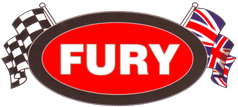Fuel System
I originally ordered the fuel tank from Steve at Fury Sportscars when I ordered the chassis back in April 2012 along with the Brake Master Cylinder and Exhaust Manifold. With these finally arriving along with the new drive shafts in December I could now get round to fitting the fuel system.
There is lots of talk on the Locost Builders website with regards to what fuel pipes to use for the fuel system. Most modern cars now days use a tough plastic pipe with fittings that the pipe is shrunk onto and these are what were fitted to the connectors that were on the Zetec engine when I bought it. Getting the pipe and connecting parts for these would be too difficult and probably not the best having fuel sat in it for long periods of time so I had two other choices. Rubber fuel line from the tank at the rear running through the centre tunnel to the engine or the other option which I chose was to have some rubber pipe from the tank up to rigid pipework that runs through the tunnel to the engine bay and then more rubber pipework to the engine. The benefits of using rigid pipework is that it won't perish and need replacing in an area that is less accessible.
With cars that are left standing for a while the problem is that the fuel can de-grade and damage the pipework so that was another reason to use the rigid pipe. Another point was that I used 'Kunifer' pipe rather than just copper pipe. 'Kunifer' is a mix of copper and nickel and this makes the pipe less prone to damage from vibration as it is slightly harder and also reacts less with the fuel. This pipe along with the return from the fuel rail were mounted along the centre tunnel just below the brake line I had installed and clipped into 8mm pipe clips.
The fuel tank came from Fury Sportscars in plain Aluminium but to provide better protection I had it powder coated, again done by Alpha Powder Coating in Peterborough this time in a bright yellow!.
The next item was a fuel pump and HP fuel filter from JJC Race and Rally. This is basically just a Bosch replacement type fuel pump and so long as it provides high pressure for fuel injection then that should be up to the job required. Some people have reported that they have had problems with a Zetec engine when trying to restart it when hot and have put this down to the fuel draining back from the LP side of the pump. To get around this I have put in a check/non-return valve after the line out from the tank and just before the LP fuel filter, which should protect the pump from ingesting anything nasty out of the fuel tank. The pump then pumps the fuel down the Kunifer pipe line to the HP filter and into the fuel rail. Then after the fuel pressure regulator there is a return line back to the top of the tank.
I was originally going to mount the fuel pump above the diff on a mounting plate but had concerns that the pump, which strictly speaking should be gravity fed would not have enough 'suck' to draw the fuel through the check valve, filter and then up to the pump. In the end I have mounted all these on a plate mounted just behind the diff on anti-vibration mountings which should allow for a good gravity feed to the pump and the pump should provide enough positive pressure to the fuel rail and return to the top of the tank for the excess.
With the electrics almost completed I thought it was about time to finish off the fuel tank. I have decided on using ETB gauges for the car so to suit I had to buy an ETB fuel gauge sender unit to match. The sender comes with an arm and float that is far too long for use in my fuel tank (and most other kits I would expect) so there are two options on what to do with regard to shortening it. One, is can be cut short and rejoined using some electrical block but the problem is that the screws will need to be lock to prevent them coming loose and the arm is in a fuel environment so thread lock would have to be able to withstand this. The other option and the one I chose was to shorten the arm while retaining the arc of the arm by putting in a series of 'z' shapes. I thought this would be best and without the worry of the arm dropping off in the tank, however the first bend went well while it could be held in a vice but the rest were hard going as the arm was made from stronger material than I was expecting. Eventually after some trial and error I managed to get the bends right so the arc swing of the arm allowed for the arm to reach the top of the tank and also almost the bottom leaving a centimetre so I had a small element in reserve.
With the arm now the correct length, I drilled a 40mm hole in the top of tank and then the holes for locating the Rivnuts which would be used to screw the sender into the tank.


.jpg)
.jpg)
.jpg)
.jpg)
.jpg)
.jpg)
.jpg)
.jpg)
.jpg)
.jpg)
.jpg)
.jpg)
.jpg)
.jpg)
.jpg)
.jpg)
.jpg)
.jpg)
.jpg)
